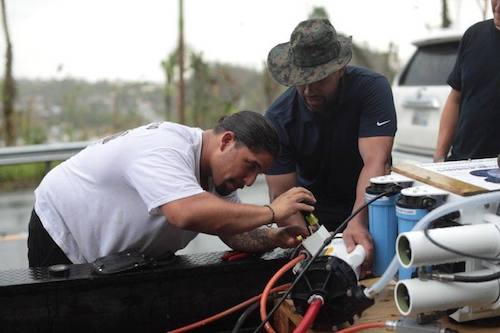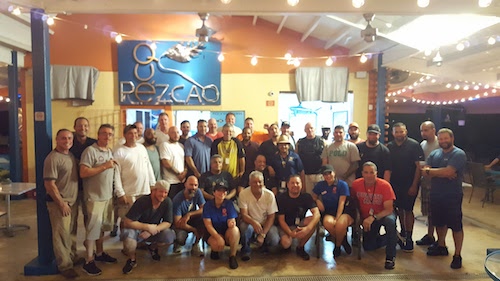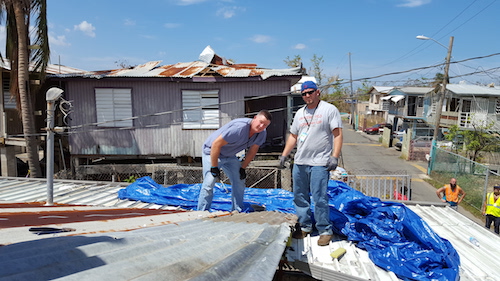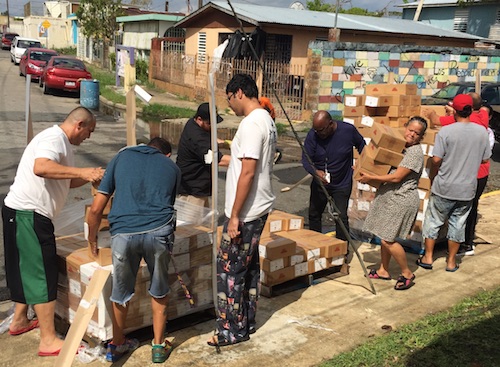New York Local 3 member Lou Alvarez has seen devastation before, but nothing prepared him for what he saw when he arrived in San Juan, Puerto Rico, leading the first group of IBEW volunteers to arrive after Hurricane Maria made landfall two weeks before.
“The destruction was unbelievable, horrible,” Alvarez said.
Huge wooden poles were snapped like toothpicks. Concrete and steel poles were ripped out of the ground, foundations still attached. Not one or two at a time either, he said. Everywhere, nearly a dozen at a time.
“I know what it takes to get things built and what it takes to destroy them. I haven’t had this feeling of destruction since 9/11, but this was everywhere, for miles and miles,” he said.
When a call went out from the AFL-CIO for IBEW volunteers to rebuild Puerto Rico, hundreds of IBEW members from around the country answered. The first group of 15 volunteers from New York Local 3 arrived Oct. 4, after Hurricane Maria pounded the island, shattering its already ailing electrical infrastructure.

|
| New York Local 3 members Emanuel Yllescas and Francisco Bueso installing a reverse osmosis water filtration system that can purify 1,800 gallons of contaminated fresh water or seawater each day.
|
Alvarez, a journeyman inside wireman and Local 3 executive board member, was chosen by Local 3 Business Manager Christopher Erikson, who is also International Executive Council Chairman, and Business Representative Benjamin Arana to be the group’s leader.
Two days later, they were joined by a crew of 12 volunteers, two from Orlando, Fla., Local 222, one from Las Vegas Local 357, seven from Miami Local 349 and two from Atlanta Local 613, led by Local 349 member Sergio Mayor.
A second group of Local 3 volunteers arrived five days after Mayor’s crew.
Alvarez’s crew drew heavily from members of the Santiago Iglesias Educational Society, a Local 3 Latino club. But the group included men and women with roots from across Central and South America to Italy and Ireland.
The average age was near 45, Alvarez said, but there was a wireman with only two years as a journeyman and another with over 30.
“They were chosen because they were eager to go and could arrange it with only three days’ notice,” Alvarez said. “We had enough volunteers to send four more planes.”
They flew down on a donated United Airlines flight with 330 union volunteers, including members of the building trades council and dozens of nurses.
After arriving, they dropped their gear at the Coliseo Roberto Clemente, a basketball arena in San Juan that Mayor quickly converted into a makeshift work camp, setting up rows of cots in a room behind the bleachers.
Alvarez and Mayor coordinated their work each morning with AFL-CIO group leaders and local political leaders in San Juan, Bayamon, Caimito and Levittown.
“We offered our services, said we were there to do whatever would help,” Alvarez said. “And they were happy to send us out.”

|
| Many of the IBEW volunteers ate dinner together the night before the first group returned home.
|
They did a little bit of everything, from repairing roofs to wiring up generators.
“An antenna array smashed one of the chillers up on the roof, and they didn’t have enough AC,” Alvarez said about the San Juan Municipal Hospital, one of the city’s public hospitals. “It was more like body and fender work than electrical work –which was pretty shoddy to begin with—so we straightened it all out and got it up and running again.”
They installed a fence at the Boys and Girls Club in Luiza. They connected two warehouses in San Juan so it could store relief supplies. They connected a generator to the teaching hospital, and every day they distributed food and water, removed downed lines, cleared debris from houses and cut down trees.
A nonprofit donated water purification systems that could treat 1,800 gallons of contaminated or sea water every day. Alvarez said the volunteers pre-wired and installed nearly a dozen in San Juan and several towns throughout the island.
The second Local 3 group, led by James Andino arrived Oct. 11, specifically tasked with getting the port back in operation. They focused first on clearing the piers, then fixing the navigation lights that help cruise ships dock and unload safely.
At the end of each long day, they returned to the Coliseo, where conditions were challenging. They only had power the first two days; at about 1 a.m. on the second day, power went out and never came back.
“That day we woke up hot, sweaty and grouchy. We were tired from the bad night’s sleep, but nobody complained,” Mayor said. “We knew there were people out there in worse conditions than us.”
While many of the volunteers had no connection to Puerto Rico, some did, and IBEW members who could not make the trip also had family that needed help. One volunteer borrowed a car from a cousin so they could get to more isolated communities. They added to their numbers when they were joined by Joseph Rufrano, a Local 3 member who happened to be in Puerto Rico before Hurricane Maria hit.
Where they could, Alvarez and Mayor said they checked in with the extended IBEW family, and when they needed help, the IBEW crew went to work.

|
| Brothers Kevin and Patrick Glennon of New York Local 3 repairing and tarping the roof of an elderly couple’s home in Catana.
|
They took portable generators and hooked them into multiple houses’ service. One woman’s house was so poorly wired, Alvarez said, that the generator wouldn’t work. They rewired the interior of her house.
Local 222 Business Manager Bill Hitt said Nelson Giboyeaux and Larry Hicks -- retired linemen who volunteered from his local-- had nearly 80 years of experience between them. They told Hitt the conditions were like nothing they’d seen.
“It was old-fashioned work. They couldn’t get heavy equipment to the jobs,” Hitt said. “If you needed a hole, you used a shovel. You needed to stand up a pole, you used a pulley and a rope.”
The scale of the catastrophe was evident everywhere, Alvarez said, but two sights stood out for him.
First were the trees.
“Puerto Rico is supposed to be green, but it looked like late fall,” he said. “The trees were stripped bare of their leaves. Even the palm trees only had one or two fronds left.”
And then there were the endless queues. Whether the neighborhood was poor or middle-class, people waited for clean water. They waited for ice to keep food from spoiling in dark refrigerators. Men and women, old and young, American citizens who looked just like Alvarez and his family, were standing in line for basics.

|
| When they weren’t doing electrical repairs, the volunteers handed out food and water to San Juan residents waiting in lines that included hundreds of people.
|
“It’s crazy, crazy, crazy,” he said. “Imagine a place twice the size of Long Island where parts of Brooklyn and Queens have power and the rest is dark – for months and months. It’s really sad.”
Even three months after the storm passed, the need was still great. In late November, Fifth District International Vice Joe Davis and International Executive Council Member Bill Riley were asked by International President Lonnie Stephenson to coordinate the distribution of 2 tractor trailers of bottled water for the Puerto Rico Relief Mission. Mayor went back to San Juan to supervise delivery and distribution.
At Christmas, one-third of the island was still without power and many of the roads were still impassable. Officials from the bankrupt, state-owned utility, Puerto Rico Electric Power Authority, said parts of the island will not have electrical service for four to six months.
Given the reports he has heard back, Miami Local 349 Business Manager Bill Riley said that might be optimistic.
“They told me it looked like years, not months,” said Riley, who is a member of the IEC. “With the appropriate funding, the IBEW could supply needed manpower, but we’re talking thousands of linemen working full time for a year just to get back to where they were before the storm.”
The volunteers began returning home the same way they arrived, in three stages, from Oct. 18-25.
The night before the first group left for home, all the IBEW volunteers gathered in a restaurant. The mood was high, he said, as it always is when brothers and sisters get together after days of demanding work. They shared a meal and a few drinks and a commitment to see the work finished.
“Everyone there would go back. We’d go back on our own dime,” Alvarez said. “That is how strongly we felt and still feel about what we are doing and what needs to get done.”
IBEW Volunteers:
|
Louis Alvarez, Local 3
Jason Rivera, Local 3
Len Copicotto, Local 3
Emanuel Yllescas, Local 3
Edwin Napoleoni, Local 3
Francisco Bueso, Local 3
Marc Estrada, Local 3
Kevin Glennon, Local 3
Patrick Glennon, Local 3
Antonio Ramos, Local 3
Christopher Nunez, Local 3
|
Frederick Torres, Local 3
Richard Ruiz, Local 3
Dan Nguyen, Local 3
Lina Lopez, Local 3
Joseph Rufrano, Local 3
James Andino, Local 3
Armando Alzaga, Local 3
Cosmo Soltren Jr., Local 3
Anthony Rodriguez, Local 3
James Proctor, Local 3
John Berenson, Local 3
|
James Tidmore, Atlanta, Ga., Local 613
Jimmy Headen, Atlanta, Ga., Local 613
Nelson Giboyeaux, Orlando, Fla., Local 222
Larry Hicks Local 222
Jorge Chavez, Las Vegas Local 357
Luis Rodriguez, Miami Local 349
Ariel Penuela, Miami Local 349
Joe Amezola, Miami Local 349
Rodolfo Porro, Miami Local 349
Pierre Luckson, Miami Local 349
Sergio Mayor, Miami Local 349
|